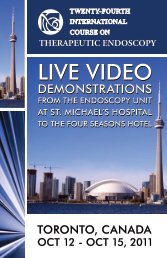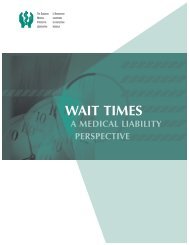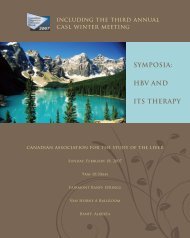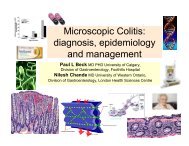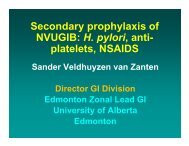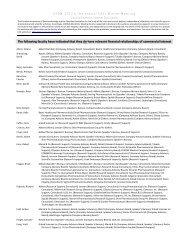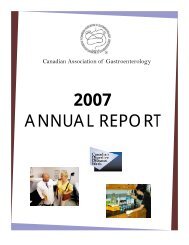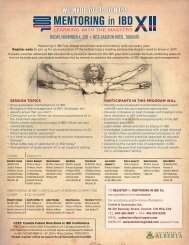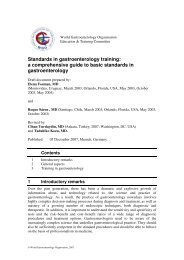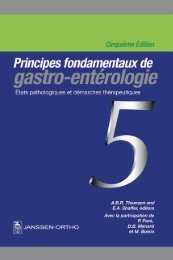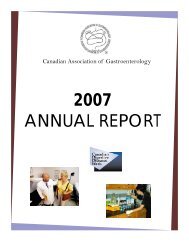Manifestations of Gastrointestinal Disease in the Child
Manifestations of Gastrointestinal Disease in the Child
Manifestations of Gastrointestinal Disease in the Child
Create successful ePaper yourself
Turn your PDF publications into a flip-book with our unique Google optimized e-Paper software.
720 FIRST PRINCIPLES OF GASTROENTEROLOGY<br />
6.1.3 FAILURE TO THRIVE<br />
In cystic fibrosis, growth failure is usually a result <strong>of</strong> a comb<strong>in</strong>ation <strong>of</strong><br />
decreased <strong>in</strong>take, loss <strong>of</strong> fat <strong>in</strong> <strong>the</strong> stools and <strong>in</strong>creased metabolic requirements.<br />
The requirements <strong>of</strong> <strong>the</strong> average cystic fibrosis patient have been<br />
reported to be 120% <strong>of</strong> normal. Never<strong>the</strong>less, some patients have essentially<br />
normal caloric requirements, and o<strong>the</strong>rs may have requirements <strong>in</strong> excess <strong>of</strong><br />
150% <strong>of</strong> normal.<br />
Infants with growth failure after pancreatic enzymes are <strong>in</strong>troduced, and<br />
whose status is not improv<strong>in</strong>g on oral feeds, may require nasogastric tube<br />
supplementation ei<strong>the</strong>r by bolus or cont<strong>in</strong>uous nocturnal feeds. Often <strong>the</strong>se<br />
are <strong>in</strong>fants who have significant pulmonary difficulties, and/or have had bowel<br />
surgery. In most cases <strong>the</strong> nasogastric feeds would be required only for weeks<br />
or months. Breast milk is encouraged but many <strong>in</strong>fants and toddlers are given<br />
supplementary high-calorie formulas until <strong>the</strong>y have demonstrated appropriate<br />
catch-up growth and are tak<strong>in</strong>g milk and solid foods well.<br />
In <strong>the</strong> early childhood years, most ma<strong>in</strong>ta<strong>in</strong> <strong>the</strong>ir nutritional status well with<br />
appropriate pancreatic enzyme supplementation and good nutrition. Unfortunately,<br />
<strong>the</strong> <strong>in</strong>creased caloric requirements <strong>of</strong> puberty coupled with deteriorat<strong>in</strong>g<br />
lung function <strong>of</strong>ten make it impossible for <strong>the</strong> more severely affected<br />
patients to ma<strong>in</strong>ta<strong>in</strong> adequate caloric <strong>in</strong>take for normal growth. In addition,<br />
CF patients may develop anorexia dur<strong>in</strong>g chronic disease or have difficulty<br />
eat<strong>in</strong>g due to chronic cough. They present with a gradual decrease <strong>in</strong> growth<br />
percentiles, first <strong>of</strong> <strong>the</strong> weight and subsequently <strong>of</strong> <strong>the</strong> height. Puberty may be<br />
delayed or arrested <strong>in</strong> <strong>the</strong> early stages. At this time, nutritional supplementation<br />
becomes extremely important. Pancreatic enzyme supplementation must<br />
be maximized and nutritional supplementation given ei<strong>the</strong>r orally or by enteral<br />
tube feed<strong>in</strong>g. Total parenteral nutrition is rarely required. If enteral feeds are<br />
needed, nasogastric tube feed<strong>in</strong>g can be successfully <strong>in</strong>itiated <strong>in</strong> most patients.<br />
(Significant nasal polyps can be a contra<strong>in</strong>dication.) Patients as young as four<br />
years <strong>of</strong> age can be taught to put <strong>the</strong> tube down nightly. In most cases, once<br />
<strong>the</strong>y have <strong>in</strong>creased <strong>the</strong>ir weight <strong>the</strong> tube feed<strong>in</strong>gs can be done five to six<br />
nights a week for eight to 10 hours. The supplement chosen for <strong>the</strong>se enteral<br />
feeds should be a complete high-calorie, age-appropriate formula. Pancreatic<br />
enzymes can be given orally prior to <strong>the</strong> tube feed<strong>in</strong>g. Supplemental enteral<br />
feed<strong>in</strong>g <strong>of</strong> <strong>the</strong> older child or adolescent may only be required for one to two<br />
years while <strong>the</strong>y are advanc<strong>in</strong>g through puberty but more commonly <strong>the</strong>re will<br />
be a long term requirement. For many patients a gastrostomy tube would<br />
be <strong>in</strong>dicated, particularly <strong>in</strong> <strong>the</strong> presence <strong>of</strong> very poor lung function. Such<br />
decisions should be made with <strong>in</strong>put from <strong>the</strong> patient and parents, as well as<br />
<strong>the</strong> multidiscipl<strong>in</strong>ary cystic fibrosis cl<strong>in</strong>ic team.



